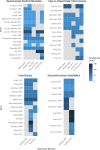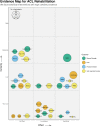Rehabilitation after anterior cruciate ligament and meniscal injuries: a best-evidence synthesis of systematic reviews for the OPTIKNEE consensus
- PMID: 35768181
- PMCID: PMC9726950
- DOI: 10.1136/bjsports-2022-105495
Rehabilitation after anterior cruciate ligament and meniscal injuries: a best-evidence synthesis of systematic reviews for the OPTIKNEE consensus
Abstract
Objective: Synthesise evidence for effectiveness of rehabilitation interventions following ACL and/or meniscal tear on symptomatic, functional, clinical, psychosocial, quality of life and reinjury outcomes.
Design: Overview of systematic reviews with Grading of Recommendations Assessment, Development and Evaluation certainty of evidence.
Data sources: MEDLINE, EMBASE, CINAHL, SPORTDiscus and Cochrane Library.
Eligibility criteria: Systematic reviews of randomised controlled trials investigating rehabilitation interventions following ACL and/or meniscal tears in young adults.
Results: We included 22 systematic reviews (142 trials of mostly men) evaluating ACL-injured individuals and none evaluating isolated meniscal injuries. We synthesised data from 16 reviews evaluating 12 different interventions. Moderate-certainty evidence was observed for: (1) neuromuscular electrical stimulation to improve quadriceps strength; (2) open versus closed kinetic chain exercises to be similarly effective for quadriceps strength and self-reported function; (3) structured home-based versus structured in-person rehabilitation to be similarly effective for quadriceps and hamstring strength and self-reported function; and (4) postoperative knee bracing being ineffective for physical function and laxity. There was low-certainty evidence that: (1) preoperative exercise therapy improves self-reported and physical function postoperatively; (2) cryotherapy reduces pain and analgesic use; (3) psychological interventions improve anxiety/fear; and (4) whole body vibration improves quadriceps strength. There was very low-certainty evidence that: (1) protein-based supplements improve quadriceps size; (2) blood flow restriction training improves quadriceps size; (3) neuromuscular control exercises improve quadriceps and hamstring strength and self-reported function; and (4) continuous passive motion has no effect on range of motion.
Conclusion: The general level of evidence for rehabilitation after ACL or meniscal tear was low. Moderate-certainty evidence indicates that several rehabilitation types can improve quadriceps strength, while brace use has no effect on knee function/laxity.
Keywords: anterior cruciate ligament; exercise; knee; rehabilitation.
© Author(s) (or their employer(s)) 2022. Re-use permitted under CC BY-NC. No commercial re-use. See rights and permissions. Published by BMJ.
Conflict of interest statement
Competing interests: AGC, BP and JLW are Associate Editors of BJSM. KMC is a senior advisor of BJSM. All other authors declare no competing interests.
Figures




References
-
- Smith TO, Postle K, Penny F, et al. . Is reconstruction the best management strategy for anterior cruciate ligament rupture? A systematic review and meta-analysis comparing anterior cruciate ligament reconstruction versus non-operative treatment. Knee 2014;21:462–70. 10.1016/j.knee.2013.10.009 - DOI - PubMed
Publication types
MeSH terms
LinkOut - more resources
Full Text Sources
Medical
